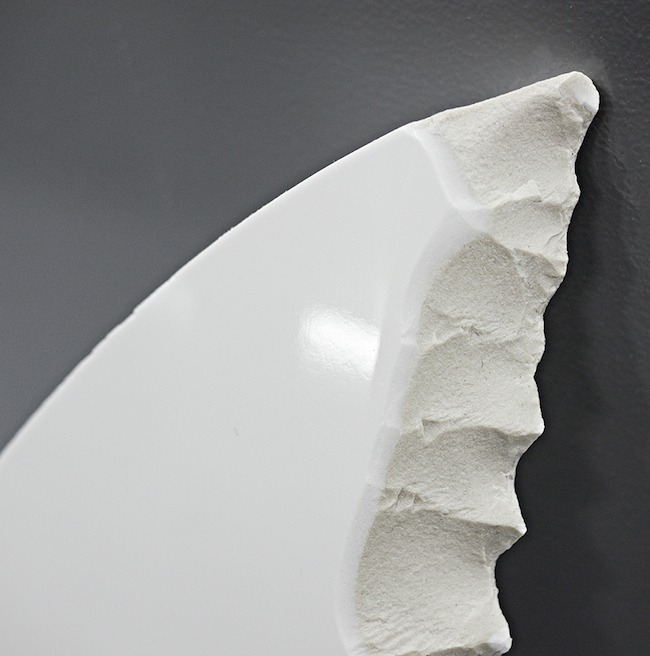From Wikipedia: Lithic fragments, or lithics, are pieces of other rocks that have been eroded down to sand size and now are sand grains in a sedimentary rock. They were first described and named (in their modern definitions) by Bill Dickinson in 1970. Lithic fragments can be derived from sedimentary, igneous or metamorphic rocks).
Artist Nina Koennemann recently wrapped up an exhibition at Taylor Macklin in Zurich, Switzerland. In Lithic Reductions (June 6 – Aug. 18) the artist used porcelain to recreate the primitive (but exacting) process of making stone tools. The sense of age from the works is tempered by Nina’s choice of material and by their display in a modern-looking paint shop. Readers who are interested in the form may wish to read our earlier post about Michal Fargo’s “cutting tools.” The following is a statement from the gallery:
In an installation specifically conceived for the former paint spraying booth at Taylor Macklin, Nina Koennemann presents a series of porcelain objects based on prehistoric tools.
The development of stone tools is believed to correspond to the evolution of human intelligence. To produce a spearhead, one must be able to visualize in a given stone the finished object as well as plan a course of successively related actions. However, one does not see in all stone tools evidence of the strategic thinking required to produce them; the earliest tools produced by Man can hardly be distinguished from stones broken by natural causes.

Today the production of stone tools is known in a popular subculture of practicing hobbyists as “knapping.” These hobbyists attempt to replicate neolithic artifacts, contextualizing their works with technical speculation, esoteric projections of stone-age thinking, and imagined narratives of survival and scarcity. In the present installation, Koennemann displays works she produced following the methods described by knappers, focusing on their use of modern-day refuse such as sanitary porcelain as an inexpensive substitute for stone.
Through persistent blows, small flakes were broken from the objects until the intended shape was reached. In this repetitive process, each impact can potentially destroy the object; if a blow strays, or if the force applied by the knapper is incorrect, the object can crack through the center, effectively rendering it worthless as a tool and making it impossible to continue. The repetitive assumption of risk involved in the process might be compared to that of games of chance.


Koennemann has in previous works depicted the confluence of recreational and subsistence activities. Her film Sommerleute (2009) portrays ordinary residents in the streets of Berlin collecting bottles to trade for their deposit value.
Love contemporary ceramic art? Let us know in the comments.



Click to see a larger image.

Nina Koennemann, Lithic Reductions (installation views), 2015 at Taylor Macklin in Zurich, Switzerland. Photographs courtesy of the gallery.



Add your valued opinion to this post.